
» Aardenburg
» Abbey of Ter Doest
» Adegem
» Bruges
» Castle of Middelburg
» Donk
» Dudzele
» Fort of Bavaria
» Knokke-Heist
» Koolkerke
» Lissewege
» Maldegem
» Male
» Middelburg
» Oedelem
» Sint-Anna-Ter-Muiden
» Sluis
 |
Sluis
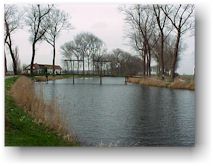 When
you follow the Napoleoncanal (Damse Vaart) from Damme in
northern direction, you eventually end up in Sluis. Sluis lies
in Zeeuws-Vlaanderen (Netherlands) and is at present day a busy
shopping town. Sluis owes her existence - and also her decay -
to the silting up of the Zwin. Because of this silting up,
successively Damme,
Monnikenrede, Hoeke,
Muyden and eventually Sluis became the
ports of
Bruges. This brought great prosperity to all these ports.
Nowadays, Sluis is also cut off from the sea. Sluis was the
last harbour of Bruges, nevertheless regularly Bruges had to
intervene by arms to enforce her rights. Practically all the
goods that were imported via the Zwin had to be traded on the
markets of Bruges or Damme. Sluis probably is the most Flemish
town of the Netherlands; the people from Sluis truly boast on
their Flemish roots. When
you follow the Napoleoncanal (Damse Vaart) from Damme in
northern direction, you eventually end up in Sluis. Sluis lies
in Zeeuws-Vlaanderen (Netherlands) and is at present day a busy
shopping town. Sluis owes her existence - and also her decay -
to the silting up of the Zwin. Because of this silting up,
successively Damme,
Monnikenrede, Hoeke,
Muyden and eventually Sluis became the
ports of
Bruges. This brought great prosperity to all these ports.
Nowadays, Sluis is also cut off from the sea. Sluis was the
last harbour of Bruges, nevertheless regularly Bruges had to
intervene by arms to enforce her rights. Practically all the
goods that were imported via the Zwin had to be traded on the
markets of Bruges or Damme. Sluis probably is the most Flemish
town of the Netherlands; the people from Sluis truly boast on
their Flemish roots.
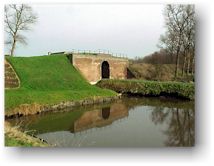 Sluis
came to existence in the second half of the 13th century and
received her town privileges in 1290. Untill 1324, this place
was called Lamminsvliet; only after that date people started
calling it Sluis. Pretty soon Sluis became an reinforced town:
in 1382, Louis van Male (count of Flanders) had the place
fortified. The construction of the castle commenced in 1385; in
1794 it was however that much damaged by French artillery that
it was torn down in 1820. Other defence constructions did
servive till present day. The town center was completely
encircled by walls which now have become a very nice walking
route. The most impressive gate was the Westgate or "Steenen
Beer" (Stone Bear), which was destroyed in 1437 by soldiers from
Bruges, but was rebuilt lateron. The fortified town was even
more strengtened when the duke of Parma showed up in the area
(80-years war). A last modification was done in 1702 by Menno
van Coehoorn(Spanish Successionwar). Sluis
came to existence in the second half of the 13th century and
received her town privileges in 1290. Untill 1324, this place
was called Lamminsvliet; only after that date people started
calling it Sluis. Pretty soon Sluis became an reinforced town:
in 1382, Louis van Male (count of Flanders) had the place
fortified. The construction of the castle commenced in 1385; in
1794 it was however that much damaged by French artillery that
it was torn down in 1820. Other defence constructions did
servive till present day. The town center was completely
encircled by walls which now have become a very nice walking
route. The most impressive gate was the Westgate or "Steenen
Beer" (Stone Bear), which was destroyed in 1437 by soldiers from
Bruges, but was rebuilt lateron. The fortified town was even
more strengtened when the duke of Parma showed up in the area
(80-years war). A last modification was done in 1702 by Menno
van Coehoorn(Spanish Successionwar).
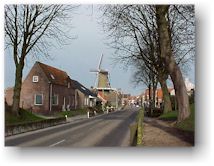 In
1568, the 80-years war between Spain and the Northern
Netherlands started. In 1587, the duke of Parma conquered the
town. Spanish galleys used the harbour as base and dominated
during many years the Zwin estuary. All things changed when, in
1604, the Spanish governor left the bastion. Prince Maurits of
Nassau, settled in the town. The same year, he also took the
town of
Aardenburg. South of Sluis, a line of fortifications was
put in place, the access to the Zwin was shut off, town walls
were strengthened, fortresses on both sides of the front,... In
that time, around Damme the 7-star-shaped fortifications were
built. The
bastion Damme served as defence bastion for Bruges against
hostile Sluis. In
1568, the 80-years war between Spain and the Northern
Netherlands started. In 1587, the duke of Parma conquered the
town. Spanish galleys used the harbour as base and dominated
during many years the Zwin estuary. All things changed when, in
1604, the Spanish governor left the bastion. Prince Maurits of
Nassau, settled in the town. The same year, he also took the
town of
Aardenburg. South of Sluis, a line of fortifications was
put in place, the access to the Zwin was shut off, town walls
were strengthened, fortresses on both sides of the front,... In
that time, around Damme the 7-star-shaped fortifications were
built. The
bastion Damme served as defence bastion for Bruges against
hostile Sluis.
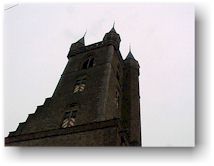 A
last attempt to connect Bruges with the sea was done by
Napoleon. He had Spanish prisoners of war dig a canal between
Bruges and Sluis (Damse Vaart). The goal of this venture was to
make a link with the Westerschelde in Breskens. Because of his
defeat, Napoleon's canal was never finished; the diggers didn't
get further than Hoeke.
Only in 1858, the last miles towards Sluis were completed. The
canal nowadays is an important tourist attraction for the town. A
last attempt to connect Bruges with the sea was done by
Napoleon. He had Spanish prisoners of war dig a canal between
Bruges and Sluis (Damse Vaart). The goal of this venture was to
make a link with the Westerschelde in Breskens. Because of his
defeat, Napoleon's canal was never finished; the diggers didn't
get further than Hoeke.
Only in 1858, the last miles towards Sluis were completed. The
canal nowadays is an important tourist attraction for the town.
Charles the Temerary
married Margareta of York in Damme. His father, Filips the Good
of Burgundy, choose Sluis for his wedding with Isabella of
Portugal. Each town her share. According to the legend,
'Jantje van Sluis' avoided the capture of the town by the
Spanjards. When the town clock struck 3, the besiegers would
have attacked Sluis. Jantje was assigned to ring the bells, but
he partied too much with his friends and fell asleep. The bells
didn't ring and the Spanish postponed their attack. Another
famous person from Sluis is Johan Hendrik van Dale, the writer
of the 'Dikke van Dale' (the most important Dutch dictionary),
who was Flemish.
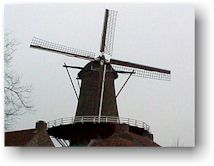 Sluis
used to have 2 churches: the Onze-Lieve-Vrouwekerk and the
Sint-Janskerk. The last one was torn down in 1823, after it
burnt down in 1811. The present church was only built in the
20th century. The pride of the town however, is the belfort
annex town hall. This belfort is the only one in the
Netherlands! In 1960, a carillon was placed in the tower.
Inside the town walls also stands a windmill which was restored
after it had been severely damaged in World War II. Sluis
used to have 2 churches: the Onze-Lieve-Vrouwekerk and the
Sint-Janskerk. The last one was torn down in 1823, after it
burnt down in 1811. The present church was only built in the
20th century. The pride of the town however, is the belfort
annex town hall. This belfort is the only one in the
Netherlands! In 1960, a carillon was placed in the tower.
Inside the town walls also stands a windmill which was restored
after it had been severely damaged in World War II.
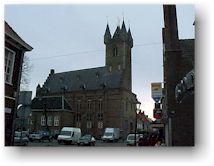 In
1944, the town was heavily bombed. There wasn't much that still
stood up right. After the war, the center was rebuilt taking
into account the historical past. Small note: in 1830 Sluis
almost belonged to Belgium. In
1944, the town was heavily bombed. There wasn't much that still
stood up right. After the war, the center was rebuilt taking
into account the historical past. Small note: in 1830 Sluis
almost belonged to Belgium.
Worth seeing: walls,
town gates, canal, quay, belfort, mill, centre of town. |











|

 When
you follow the Napoleoncanal (Damse Vaart) from Damme in
northern direction, you eventually end up in Sluis. Sluis lies
in Zeeuws-Vlaanderen (Netherlands) and is at present day a busy
shopping town. Sluis owes her existence - and also her decay -
to the silting up of the Zwin. Because of this silting up,
successively Damme,
When
you follow the Napoleoncanal (Damse Vaart) from Damme in
northern direction, you eventually end up in Sluis. Sluis lies
in Zeeuws-Vlaanderen (Netherlands) and is at present day a busy
shopping town. Sluis owes her existence - and also her decay -
to the silting up of the Zwin. Because of this silting up,
successively Damme,  Sluis
came to existence in the second half of the 13th century and
received her town privileges in 1290. Untill 1324, this place
was called Lamminsvliet; only after that date people started
calling it Sluis. Pretty soon Sluis became an reinforced town:
in 1382, Louis van Male (count of Flanders) had the place
fortified. The construction of the castle commenced in 1385; in
1794 it was however that much damaged by French artillery that
it was torn down in 1820. Other defence constructions did
servive till present day. The town center was completely
encircled by walls which now have become a very nice walking
route. The most impressive gate was the Westgate or "Steenen
Beer" (Stone Bear), which was destroyed in 1437 by soldiers from
Bruges, but was rebuilt lateron. The fortified town was even
more strengtened when the duke of Parma showed up in the area
(80-years war). A last modification was done in 1702 by Menno
van Coehoorn(Spanish Successionwar).
Sluis
came to existence in the second half of the 13th century and
received her town privileges in 1290. Untill 1324, this place
was called Lamminsvliet; only after that date people started
calling it Sluis. Pretty soon Sluis became an reinforced town:
in 1382, Louis van Male (count of Flanders) had the place
fortified. The construction of the castle commenced in 1385; in
1794 it was however that much damaged by French artillery that
it was torn down in 1820. Other defence constructions did
servive till present day. The town center was completely
encircled by walls which now have become a very nice walking
route. The most impressive gate was the Westgate or "Steenen
Beer" (Stone Bear), which was destroyed in 1437 by soldiers from
Bruges, but was rebuilt lateron. The fortified town was even
more strengtened when the duke of Parma showed up in the area
(80-years war). A last modification was done in 1702 by Menno
van Coehoorn(Spanish Successionwar). In
1568, the 80-years war between Spain and the Northern
Netherlands started. In 1587, the duke of Parma conquered the
town. Spanish galleys used the harbour as base and dominated
during many years the Zwin estuary. All things changed when, in
1604, the Spanish governor left the bastion. Prince Maurits of
Nassau, settled in the town. The same year, he also took the
town of
In
1568, the 80-years war between Spain and the Northern
Netherlands started. In 1587, the duke of Parma conquered the
town. Spanish galleys used the harbour as base and dominated
during many years the Zwin estuary. All things changed when, in
1604, the Spanish governor left the bastion. Prince Maurits of
Nassau, settled in the town. The same year, he also took the
town of
 A
last attempt to connect Bruges with the sea was done by
Napoleon. He had Spanish prisoners of war dig a canal between
Bruges and Sluis (Damse Vaart). The goal of this venture was to
make a link with the Westerschelde in Breskens. Because of his
defeat, Napoleon's canal was never finished; the diggers didn't
get further than
A
last attempt to connect Bruges with the sea was done by
Napoleon. He had Spanish prisoners of war dig a canal between
Bruges and Sluis (Damse Vaart). The goal of this venture was to
make a link with the Westerschelde in Breskens. Because of his
defeat, Napoleon's canal was never finished; the diggers didn't
get further than  Sluis
used to have 2 churches: the Onze-Lieve-Vrouwekerk and the
Sint-Janskerk. The last one was torn down in 1823, after it
burnt down in 1811. The present church was only built in the
20th century. The pride of the town however, is the belfort
annex town hall. This belfort is the only one in the
Netherlands! In 1960, a carillon was placed in the tower.
Inside the town walls also stands a windmill which was restored
after it had been severely damaged in World War II.
Sluis
used to have 2 churches: the Onze-Lieve-Vrouwekerk and the
Sint-Janskerk. The last one was torn down in 1823, after it
burnt down in 1811. The present church was only built in the
20th century. The pride of the town however, is the belfort
annex town hall. This belfort is the only one in the
Netherlands! In 1960, a carillon was placed in the tower.
Inside the town walls also stands a windmill which was restored
after it had been severely damaged in World War II.  In
1944, the town was heavily bombed. There wasn't much that still
stood up right. After the war, the center was rebuilt taking
into account the historical past. Small note: in 1830 Sluis
almost belonged to Belgium.
In
1944, the town was heavily bombed. There wasn't much that still
stood up right. After the war, the center was rebuilt taking
into account the historical past. Small note: in 1830 Sluis
almost belonged to Belgium.